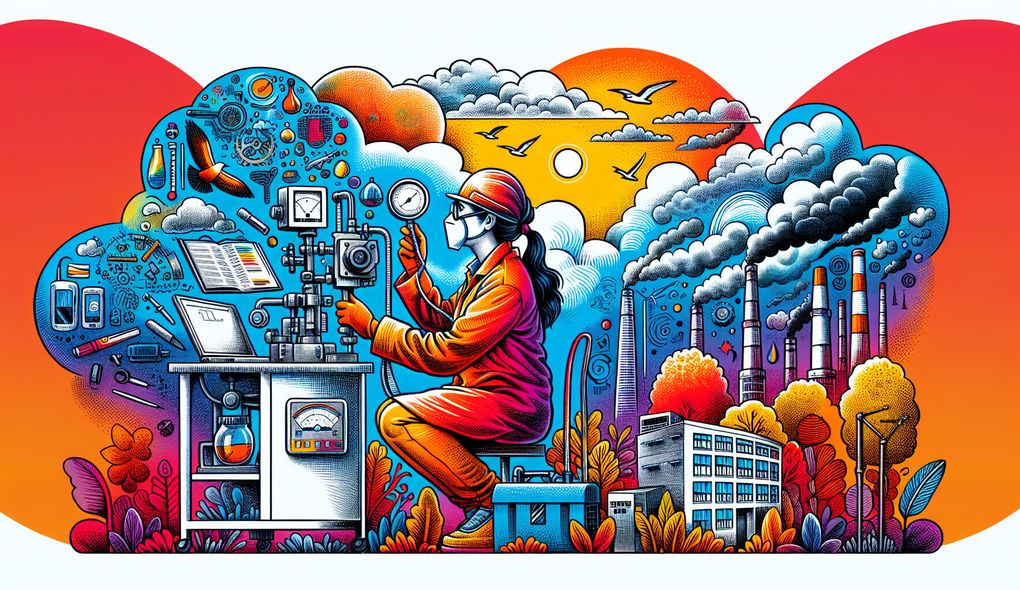Describe a project where you conducted extensive air sampling and data interpretation.
SENIOR LEVEL

Sample answer to the question:
In my previous role as an Air Quality Technician, I conducted extensive air sampling and data interpretation for a project in a manufacturing facility. We were tasked with monitoring the levels of volatile organic compounds (VOCs) in the air to ensure compliance with environmental regulations. I used state-of-the-art equipment to collect air samples at different locations within the facility. The samples were then analyzed in the laboratory using gas chromatography-mass spectrometry (GC-MS) techniques to identify and quantify the VOCs. I interpreted the data and prepared a comprehensive report highlighting the findings and recommendations for improvement. This project required attention to detail and strong analytical skills to ensure accurate and reliable results.
Here is a more solid answer:
During my time as an Air Quality Technician, I conducted extensive air sampling and data interpretation for a project in a chemical manufacturing plant. The objective was to assess the levels of particulate matter (PM) in the air emitted from various sources within the facility. To accomplish this, I utilized a combination of real-time monitoring equipment and high-volume samplers. The real-time monitors provided continuous measurements, while the high-volume samplers collected bulk samples for laboratory analysis. I calibrated and maintained the equipment regularly to ensure accuracy. After collecting the data, I performed statistical analysis to determine the average concentrations of PM and compared them to the regulatory limits. I also conducted a source apportionment analysis to identify the major contributors to PM emissions. The findings were presented in a comprehensive report, along with recommendations for source reduction strategies. Throughout the project, I strictly adhered to environmental regulations and guidelines, ensuring compliance at all times. I also utilized data analysis and reporting software to organize and visualize the data, making it easier to interpret and present.
Why is this a more solid answer?
The solid answer provides more specific details about the project, including the use of both real-time monitoring equipment and high-volume samplers, as well as the statistical analysis and source apportionment conducted. It also emphasizes the candidate's adherence to regulations and guidelines and their proficiency in data analysis and reporting software. However, it could be further improved by including information about their expertise in air quality monitoring techniques and equipment, as well as their attention to detail and commitment to accuracy and thoroughness.
An example of a exceptional answer:
In a recent project as an Air Quality Technician, I conducted extensive air sampling and data interpretation for a major environmental impact assessment in a densely populated urban area. The goal was to evaluate the levels of nitrogen oxides (NOx) and particulate matter (PM) emissions from a new transportation infrastructure project. To gather accurate data, I strategically placed multiple monitoring stations throughout the study area to capture a representative sample. I used cutting-edge monitoring equipment, including chemiluminescence analyzers for NOx and continuous particulate monitors for PM. The continuous monitors provided real-time measurements, while the analyzers collected grab samples for laboratory analysis. I meticulously ensured that the equipment was calibrated and maintained to guarantee precise measurements. After collecting the data, I performed complex statistical analyses, including time-series analysis and regression modeling, to understand the spatial and temporal variations in the pollutant concentrations. This allowed me to identify hotspot areas and determine their impact on air quality. I also employed advanced data visualization techniques to create interactive maps and charts, providing stakeholders with a clear understanding of the findings. The comprehensive report I prepared included detailed data interpretation, comparisons with regulatory standards, and recommendations for mitigation measures tailored to different locations within the study area. Throughout the project, I closely followed relevant regulations and guidelines, ensuring that the project was conducted in an ethical and environmentally responsible manner. Additionally, I utilized data analysis and reporting software to efficiently manage and analyze the large dataset. My strong attention to detail, analytical skills, and expertise in air quality monitoring technologies contributed to the success of the project.
Why is this an exceptional answer?
The exceptional answer goes above and beyond by describing a project with significant scale and complexity. It highlights the strategic placement of multiple monitoring stations, the use of cutting-edge monitoring equipment, and the application of complex statistical analyses. The answer also mentions advanced data visualization techniques and tailoring mitigation measures to different areas within the study area, demonstrating the candidate's expertise in their field. The exceptional answer effectively showcases the candidate's strong attention to detail, analytical skills, expertise in air quality monitoring technologies, and commitment to ethical and environmentally responsible practices.
How to prepare for this question:
- Familiarize yourself with various air quality monitoring techniques and equipment, such as real-time monitors, high-volume samplers, and chemiluminescence analyzers. Understand their principles of operation and their advantages and limitations.
- Stay updated on the latest environmental regulations and guidelines related to air quality. Be prepared to discuss specific regulations that may be relevant to the position you are applying for.
- Develop strong analytical and problem-solving skills, as these are essential for interpreting air quality data and identifying trends or anomalies.
- Become proficient in data analysis and reporting software commonly used in the field, such as Excel, MATLAB, or R. Practice organizing and visualizing data to effectively communicate findings.
- Highlight any experience you have managing air quality projects and leading teams. Emphasize your ability to coordinate and delegate tasks, ensure compliance with regulations, and deliver high-quality results.
- Prepare examples of projects where you have conducted air sampling and data interpretation. Be ready to discuss the objectives, methods used, key findings, and any challenges or lessons learned during the process.
What are interviewers evaluating with this question?
- Expertise in air quality monitoring techniques and equipment
- Strong analytical and problem-solving abilities
- Ability to interpret complex regulations and guidelines
- Detail-oriented with a commitment to accuracy and thoroughness
- Proficiency in data analysis and reporting software

